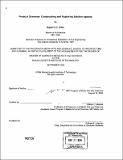| dc.contributor.advisor | William J. Mitchell. | en_US |
| dc.contributor.author | Chin, Ryan C. C., 1974- | en_US |
| dc.contributor.other | Massachusetts Institute of Technology. Dept. of Architecture. Program in Media Arts and Sciences. | en_US |
| dc.date.accessioned | 2005-09-27T18:16:20Z | |
| dc.date.available | 2005-09-27T18:16:20Z | |
| dc.date.copyright | 2004 | en_US |
| dc.date.issued | 2004 | en_US |
| dc.identifier.uri | http://hdl.handle.net/1721.1/28774 | |
| dc.description | Thesis (S.M.)--Massachusetts Institute of Technology, School of Architecture and Planning, Program in Media Arts and Sciences, 2004. | en_US |
| dc.description | Page 79 blank. | en_US |
| dc.description | Includes bibliographical references (p. 77-78). | en_US |
| dc.description.abstract | Developing a design methodology that accounts for system- and component-level parameters in the design of products is a challenge for design and manufacturing organizations. Designed products like automobiles, personal electronics, mass-customized homes, and apparel follow design processes that have evolved over time into compartmentalized approaches toward design synthesis. Many products are designed "by committee" because the nature of the problem is sufficiently sophisticated that isolating the different disciplines of engineering, design, manufacturing, and marketing has become the only way to produce a product. This thesis rethinks design methods by critically analyzing design rules and their role in product development. Systematic and unbiased mapping of possible configurations is a method employed in generative design systems. A mapping of a solution space is achieved by parameterizing the constraints of the problem in order to develop a feasible envelope of possibilities at the component and system level. Once parametric modeling begins, then a flexible hierarchical and associative assembly must be put in place to integrate components into the product structure. What results is a complex tree structure of the possible solutions that can be optimized to ergonomic, structural, aerodynamic, manufacturing and material perspectives. The tree structure is organized so that any changes in the component structure can be accommodated at any level. Subsystems can then be easily substituted in order to fit to mass-customization preferences. | en_US |
| dc.description.statementofresponsibility | by Ryan C.C. Chin. | en_US |
| dc.format.extent | 79 p. | en_US |
| dc.format.extent | 3520972 bytes | |
| dc.format.extent | 3529297 bytes | |
| dc.format.mimetype | application/pdf | |
| dc.format.mimetype | application/pdf | |
| dc.language.iso | en_US | |
| dc.publisher | Massachusetts Institute of Technology | en_US |
| dc.rights | M.I.T. theses are protected by copyright. They may be viewed from this source for any purpose, but reproduction or distribution in any format is prohibited without written permission. See provided URL for inquiries about permission. | en_US |
| dc.rights.uri | http://dspace.mit.edu/handle/1721.1/7582 | |
| dc.subject | Architecture. Program in Media Arts and Sciences. | en_US |
| dc.title | Product grammar : construction and exploring solution spaces | en_US |
| dc.type | Thesis | en_US |
| dc.description.degree | S.M. | en_US |
| dc.contributor.department | Program in Media Arts and Sciences (Massachusetts Institute of Technology) | |
| dc.identifier.oclc | 60128855 | en_US |
